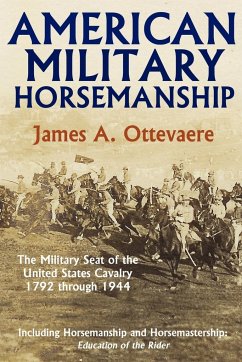During its time the United States Cavalry grew from a few squadrons of dragoons scattered across a vast frontier to what would become, by the end of the American Civil War, the largest body of mounted troops in the western world. During the post Civil War years the Cavalry would again become a small, but highly affective, mobile force charged with protecting American westward expansion. At the close of the 19th Century the United States would fight its first "foreign war" away from the protective shores of the United States. The Cavalry, although it would play only a minor role in the "small war" with Spain, would emerge as the mounted arm of a newly anointed world power. It would train its troopers to be excellent soldiers, competent horsemen and journeymen riders, mostly, in that order. How its troopers were taught to ride and how they sat a horse is the story of American Military Horsemanship and the American military riding seat. This term, "military seat" as it is often used today has various descriptions and meanings. The purpose of this book is two-fold, first it is intended to clear away some of the misunderstandings of the "military seat" and to explain its evolution in the context of United States Cavalry history, as it evolved through the end of the horse Cavalry era at the close of World War II. There is also a second, underlying purpose to this book. That is, to present to young riders, inexperienced riders, and accomplished riders, as well, the riding style and teaching methods that shaped United States Cavalry horsemen into the mid-20th Century, a style that would eventually evolve into a uniquely "American" military seat. A riding seat that is often misunderstood, yet is in wide use today and is as useful to modern horsemen as it was to the Cavalrymen of the last century.
Hinweis: Dieser Artikel kann nur an eine deutsche Lieferadresse ausgeliefert werden.
Hinweis: Dieser Artikel kann nur an eine deutsche Lieferadresse ausgeliefert werden.








